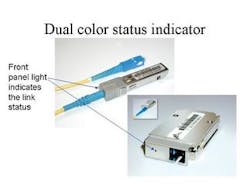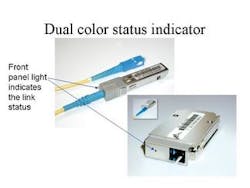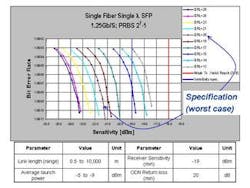Single-fiber single-wavelength gigabit transceivers
In addition to inherently low cost, these receivers can incorporate diagnostic capabilities that save on test equipment.
Richard T. Demers, Sean Zargari, Jim Stephenson, and Meir Bartur
Zonu
The majority of deployed fiber-optic communication links utilize two fibers per link, one for each traffic direction. The transceivers for such links dedicate one fiber for the receiver and one for the transmitter. Single-fiber transceivers, which collapse the bi-directional traffic onto one singlemode fiber using either one or two wavelengths for full-duplex operation, have been in use for a number of years. In particular, single-fiber single-wavelength (SFSW) transceivers have been available but did not exploit some of their inherent advantages.
This article reviews the attributes and benefits of SFSW transceivers, illuminating the advantages for point-to-point communication links. Special attention is paid to critical design elements that enable safe and reliable operation of an optical network with optical return loss (ORL) of 20 dB and better.
Cost advantages of SFSW
The most important benefit of SFSW transceivers lies in cost reduction for both network operators and component/module manufacturers. Collapse of bi-directional traffic to a single fiber results in reduced fiber plant costs or, equivalently, increased capacity. Network operators who are fiber-starved can instantly double their capacity by replacing dual-fiber transceivers with single-fiber modules and thus stave off the costly installation of new fiber plant.
The installation of single-fiber transceivers is simpler and greatly reduces the "spaghetti" or tangled cable common in high-density equipment (e.g., 48 small-form-factor pluggable transceivers on a single U-panel). The use of SFSW transceivers results in inventory cost reductions for network operators, since there is only one physical media dependent layer (PMD) specification and hence only one transceiver replacement part. Troubleshooting becomes easier and faster due to the simplicity of a single transceiver part for both link terminals. There will also be a reduction in the number of installed fiber connectors and splices as well as stocked replacement parts.
Transceiver module manufacturers also benefit from the single-fiber, single-lambda link design. Cost savings result from a reduced bill of materials and streamlined inventory, since SFSW transceivers require only one type of laser diode, one type of beam splitter/combiner, one fiber ferrule, and a single fiber pigtail. The major component of cost for dual-wavelength single-fiber links is the distributed feedback (DFB) laser required at the 1.5-micron wavelength range due to dispersion effects that limit operation above 1 Gbit/sec. The use of 1310-nm Fabry-Perot lasers with SMF-28 type fiber enables the transceivers to satisfy the requirements for 10- to 20-km links at Gigabit Ethernet rates. This is due to the fact that 1310 nm is the zero-dispersion wavelength for SMF-28, the most common fiber. To operate the same link with a 1550-nm source, the more costly DFB laser must be used to provide an adequate link.
The SFSW transceiver design does not require costly optical filters and the WDMs that are necessary for single- fiber dual-wavelength transceivers. Manufacturing costs savings are also realized by judicious selection of the lowest cost subcomponents capable of meeting the requirements for link performance and reliability. For example, the lowest cost laser that will support propagation over singlemode fiber is the 1310-nm Fabry-Perot laser with a ball lens cap. Compared with other lenses, the ball lens introduces significant optical aberrations. However, with rigorous alignment between laser and fiber the maximum possible coupling efficiency allowed by the ball lens is achieved, resulting in a launched fiber power that is adequate for 20-km links.
Technical advantages
There are several technical advantages of SFSW transceivers compared to dual-fiber and single-fiber dual -wavelength transceivers. The most distinct technical advantage is the ability to operate the transceiver as an optical time-domain reflectometer (OTDR) that can be used to detect faults such as open connectors, fiber breaks, or poor splices. Since the transmit and receive signals are at the same wavelength, simple features can be implemented to detect and recognize reflections. This enables components built into the network itself to act as surrogates for expensive test equipment that can identify and locate faults.
The main problem encountered with SFSW transceiver installation stems from the optical reflections on the distribution network (fiber, connectors, and splices). A built-in OTDR and microprocessor would be used to test the link on installation to detect faults due to either fiber plant or transceiver failure prior to data transmission. The microprocessor-based "state machine" would then provide a link status indication to the installer. In the event of fault detection, the state machine provides troubleshooting instructions to the installer (e.g., clean local connectors, recycle power, replace transceiver, etc.). The state machine user interface can be as advanced as a miniature display or as simple and compact as a dual color blinking LED on the front of the transceiver.
The state machine can also transmit link status to the network operator through a standard small-form-factor pluggable (SFP) or gigabit interface converter (GBIC) I²C serial interface that is already incorporated in the multisource agreement for these transceivers. Figure 1 shows SFSW transceivers in SFP and GBIC packages with LED user interface. Transceivers with a built-in state machine such as these have demonstrated a fault location accuracy of 100 m.
The state machine described here is a powerful diagnostic tool that can be built into a SFSW transceiver. It is an inherent feature resulting from the fact that the identical wavelength is used by both transmitter and receiver. The parts necessary for such a diagnostic (laser source, detector, and microprocessor) are already built into the transceiver, so the only additional cost is incurred by the firmware.
The automated link testing and troubleshooting executed by the state machine can relieve the network operator of the time-consuming task of conducting diagnostics during installation and following faults. A state machine is capable of discriminating between local, intermediate, and remote faults as well as between fiber plant and transceiver hardware resulting in operating cost savings.
Due to the simplicity of the SFSW design and reduced subcomponent count the transceivers are inherently more reliable. The symmetry of fiber dispersion and losses due to the single wavelength eases system design constraints and simplifies fiber plant test and maintenance requirements. Furthermore, data link speeds of either 125 Mbits/sec or 1.25 Gbits/sec are possible and have been demonstrated with a single PINTIA receiver. Thus, a low-speed link can be upgraded at no cost by replacing the switch-fabric, which is currently more price-sensitive than optics.
The SFSW fiber-optic link also can be augmented or upgraded with additional channels. By use of WDM splitter/combiners in the network, a second wavelength channel can be overlaid. Identically, a CWDM, DWDM, CATV, or digital broadcast channel can be added.
Because the transmit and receive wavelengths in a SFSW transceiver are the same, the link is more susceptible to crosstalk than a dual-wavelength link. To the receiver the reflections from the optical distribution network (ODN) appear as noise that can increase the bit-error rate (BER). The effect of return loss from the ODN on 1.25-Gbit/sec receiver sensitivity has been measured parametrically. The results, shown graphically in Figure 2, demonstrate that for a worst case ODN return loss of 20 dB the receiver sensitivity is better than -21 dBm. This exceeds the 19 dBm sensitivity specification for Gigabit Ethernet.
Richard T. Demers is the senior optical engineer; Sean Zargari is director, digital fiber optic interface; Jim Stephenson is director, embedded processing; and Meir Bartur is president and CEO of Zonu, Inc. (Tarzana, CA).

